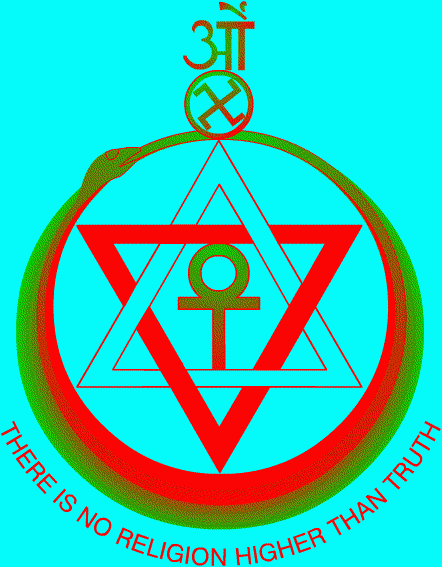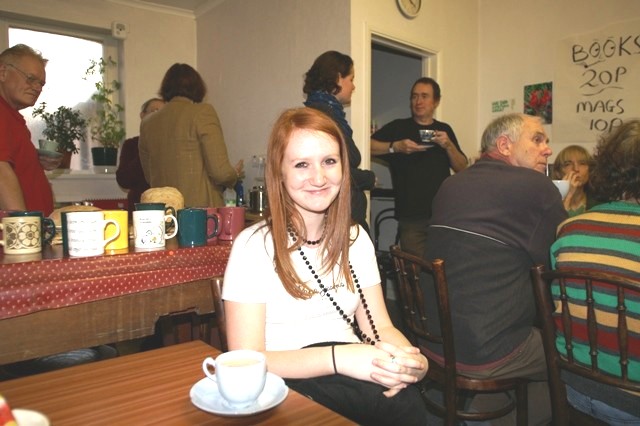Explanation of the Emblem of the Theosophical Society

The emblem of the Theosophical Society is
composed of a number of
symbols,
all of them having been used from ancient times to express
profound
spiritual and philosophical concepts about humanity and the
universe.
They may be found in a variety of forms
in the great religions of the world
and their universality is further shown
by their appearance in widely
separated cultures.
Each symbol, studied separately, will
yield a wealth of understanding, but
none of them can be interpreted with a
narrow precision. Taken together as
in the Society's emblem, they represent a
unity of meaning, suggesting a
vast evolutionary scheme embracing the
whole of nature, physical and
spiritual. Study and contemplation of the
emblem as well as its several
component symbols will lead the serious
student to an awareness of some
of the deepest mysteries of existence.
The
Serpent

The Serpent is the timeless symbol of the
highest spiritual Wisdom.
Swallowing its tail, it is a symbol of
regeneration. It is the self-born,
the circle of infinite wisdom, life and
immortality. The circle itself is
an ancient symbol of eternity and
represents the Absolute, the
unmanifested
universe containing the potentials of all form. As
representative of the infinite sphere,
the 'world egg' of archaic
cosmology, this symbol is found in every
world religion and philosophy.
The Interlaced Triangles

The interlaced triangles, one (lighter)
pointing upwards and the other
(darker) pointing downwards, symbolize
the descent of spirit into matter
and its re-emergence from the confining
limits of form. They also suggest
the constant conflict between the light
and dark forces in nature as well
as the inseparable unity of spirit and
matter. When depicted within the
circle of the serpent, the figure
represents the universe and the
manifestation of Deity in time and space.
The three lines and three angles
of each of the two triangles may remind
us of the triple aspects of
spirit: existence, consciousness and bliss,
and the three aspects of
matter: mobility, resistance and rhythm.
The glyph can also be seen as the
six-pointed star, embracing spiritual and
physical consciousness and
viewed by the Pythagoreans as the symbol
of creation.
The Ankh

In the centre of the emblem is the Ankh
or Crux Ansata, an ancient
Egyptian symbol of resurrection. It is
composed of the Tau or T-shaped
cross surmounted by a small circle and is
seen in Egyptian statuary and in
wall and tomb paintings where it is
depicted as being held in the hand.
The Tau
symbolizes matter or the world of form; the small circle above it
represents spirit or life. With the
circle marking the position of the
head, it represents the mystic cube
unfolded to form a Latin cross, symbol
of spirit descended into matter and
crucified thereon, but risen from
death resting triumphant on the arms of
the conquered slayer. So it may be
said that the figure of the interlaced
triangles enclosing the ankh
represents the human triumphant and the
divine triumphant in the human. As
the cross of life, the ankh becomes a symbol
of resurrection and
immortality.
The Jaina Cross

Placed in the emblem at the head of the
serpent, is one of the numerous
forms in which the symbol of the cross is
found. It is a fiery cross, with
arms of whirling flame revolving
clockwise to represent the tremendous
energies of nature incessantly creating
and dissolving forms through which
the evolutionary process takes place.
In religions which recognise
three aspects of Deity, the Jaina Cross is
associated with the Third Person of the
Trinity, who is at once the
Creator and the Destroyer: Shiva in
Hinduism and the Holy Ghost in
Christianity. Applied to humanity, the
figure may show the human as the
link between heaven and earth, one 'hand'
pointing to heaven or spirit and
the other toward earth or matter.
Aum

Above the emblem, in Sanskrit characters,
is the sacred word of Hinduism,
Aum or
the creative Word
or Logos, the ineffable Reality, which is the source of
all existence. We are reminded of the
statement: 'In the beginning was the
Word, and the Word was with God, and the
Word was God'. Om is a word
of power and
should be uttered only with the greatest reverence.
MOTTO
There is no religion higher than truth
Around the emblem appears the MOTTO of
the Theosophical Society.
Truth is
the quest of every Theosophist, whatever his or her faith, and every
great
religion reflects in some measure the light of the one eternal and
spiritual wisdom. Each points a way
toward the realisation of Truth.
The Whole
Emblem
Speaks to an inner perception, to the
intuition and to the heart, calling
forth the divine in each individual who
contemplates it. In its totality,
it represents a synthesis of great cosmic
principles operating through
involutionary
and evolutionary cycles, bringing us all, in the fullness of
time, to the realisation
of our divine nature.
Try these links for
more
info about Theosophy

Cardiff
Theosophical Society meetings are informal
and there’s always
a cup of tea afterwards
The
Cardiff Theosophical Society Website
The National Wales Theosophy
Website
Theosophy
Cardiff’s Instant Guide to Theosophy
Theosophy
Cardiff’s Gallery of Great Theosophists
Dave’s Streetwise
Theosophy Boards
The Theosophy Website that
welcomes
If you run a Theosophy Study
Group, please
feel free to use any material on
this Website
Independent Theosophy Blog
The Most Basic
Theosophy
Website in the Universe
A quick
overview of Theosophy
and the Theosophical Society
If you run a
Theosophy Study Group you
can use this as an
introductory handout.
One liners and quick explanations
About aspects of Theosophy
The
Voice of the Silence Website
An Independent
Theosophical Republic
Links to Free Online
Theosophy
Study Resources; Courses, Writings,
The main criteria for the
inclusion of
links on this site is that they
have some
relationship (however tenuous) to
Theosophy
and are lightweight, amusing or
entertaining.
Topics include Quantum Theory
and Socks,
Dick
Dastardly and Legendary Blues Singers.
An entertaining
introduction to Theosophy
For
everyone everywhere, not just in Wales
It’s all “water under the
bridge” but everything you do
makes an imprint on the Space-Time
Continuum.
A selection of articles on
Reincarnation
Provided in response to the
large number
of enquiries we receive on this
subject
No
Aardvarks were harmed in the
The
Spiritual Home of Urban Theosophy
The
Earth Base for Evolutionary Theosophy
____________________________________
A B C D EFG H IJ KL M N OP QR S T UV WXYZ
Complete
Theosophical Glossary in Plain Text Format
1.22MB
___________________________
Classic Introductory
Theosophy Text
A Text Book of Theosophy By C
What Theosophy Is From the Absolute to Man
The Formation of a Solar System The Evolution of Life
The Constitution of Man After Death Reincarnation
The Purpose of Life The Planetary Chains
The Result of Theosophical Study
_____________________
Preface to the American Edition Introduction
Occultism and its Adepts The Theosophical Society
First Occult Experiences Teachings of Occult Philosophy
Later Occult Phenomena Appendix
Try these if you are
looking for a
local
Theosophy Group or Centre
UK Listing of
Theosophical Groups

General pages about Wales,
Welsh History
and The History of Theosophy in
Wales
Wales is a
Principality within the United Kingdom
and has an eastern border
with England.
The land area is
just over 8,000 square miles.
Snowdon in North Wales is the highest mountain at 3,650 feet.
The coastline is
almost 750 miles long.
The population of Wales as at the 2001 census
is 2,946,200.